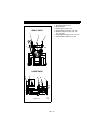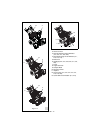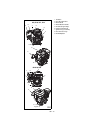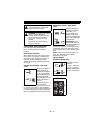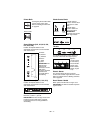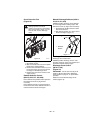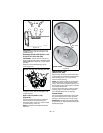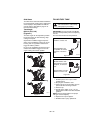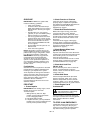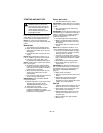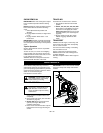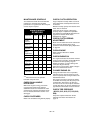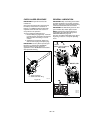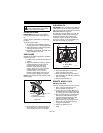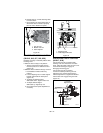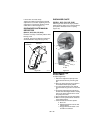
GB - 21
GASOLINE
IMPORTANT: ALWAYS use gasoline that
meets the following guidelines:
• Clean, fresh gasoline.
• A minimum of 87 octane/87 AKI (91
RON). High altitude use may require a
different octane. Consult your engine
manual.
• Gasoline with up to 10% ethanol
(gasohol) or up to 15% MTBE (methyl
tertiary butyl ether) is acceptable.
• Use of any gasoline other than those
approved above may void the engine
warranty. If the pumps are not marked
for the content of alcohol or ethers,
check ethanol and MTBE levels with
the fuel supplier.
• Do not modify the fuel system to use
different fuels.
• Never mix oil and gasoline.
NOTE: All gasoline is not the same. If the
engine experiences starting or performance
problems after using a new gasoline, switch
to a different fuel provider or fuel brand.
IMPORTANT: Excessively oxygenated or
reformulated fuels (fuels blended with
alcohols or ethers) can damage the fuel
system or cause performance problems. If
any undesirable operating problems occur,
use a gasoline with a lower percentage of
alcohol or ether.
Fuel Stabilizer
Gasoline left in the fuel system for extended
periods without a stabilizer will deteriorate,
resulting in gum deposits in the system.
These deposits can damage the carburetor
and the fuel hoses, filter and tank. Prevent
deposits from forming in the fuel system
during storage by adding a quality fuel
stabilizer to the fuel. Follow the
recommended mix ratio found on the fuel
stabilizer container.
PRE-START
1. Frozen Impeller
IMPORTANT: Before starting engine, check
impeller to be sure it is not frozen.
To check impeller:
1. With ignition key switch in “Stop”
position, squeeze Attachment Clutch
Lever to Engaged position.
2. Pull Recoil Starter Handle.
3. If Impeller is frozen, (cannot pull Starter
Handle) move unit to a heated area and
thaw to prevent possible damage.
2. Check Function of Clutches
If clutches do not engage or disengage
properly, adjust or repair before operation.
See Attachment Clutch/Brake Adjustment on
page 29 and Traction Drive Clutch
Adjustment on page 31.
3. Check Dual Handle Interlock
Without the engine running, press down
(engage) both clutch levers. Release
attachment clutch lever. Attachment clutch
should remain engaged until traction clutch
lever is released, then both clutches must
disengage.
If clutches do not engage or disengage
properly, adjust or repair before operation
(see Attachment Clutch/Brake Adjustment on
page 29 and Traction Drive Clutch
Adjustment on page 31).
4. Check Remote Wheel Lock
(921012, 013, 020)
Squeeze and release the remote wheel lock
control to lock the left wheel for better traction
when throwing snow or to unlock the left
wheel for easier steering.
If remote wheel lock does not lock or unlock
properly, adjust or repair before operation
(see Remote Wheel Lock on page 26).
5. Check Axle Lock Pins
(921011, 019)
Use the axle lock pins to lock or unlock the
wheels. Lock both wheels to increase
traction; unlock one wheel to allow for easier
turning of the unit.
6. Check Skid Shoes
Check and adjust Skid Shoes (See Skid
Shoes on page 26). Allow 1/8 in. (3 mm)
between scraper blade and hard, smooth
surface(s). Allow 1-1/4 in. (30 mm) between
scraper blade and uneven or gravel surfaces.
7. Check Engine Fuel &
Crankcase Oil
Check and add fuel if required. Check that
the engine crankcase oil is full using dipstick.
Refer to Engine Manual for detailed
instructions.
TO STOP IN AN EMERGENCY
Immediately release both control levers to
stop unit in an emergency. Stop engine,
remove key and wait for all rotating parts to
stop before leaving operator’s position.
WARNING: AVOID INJURY. Read
and understand the entire Safety
section before proceeding.



